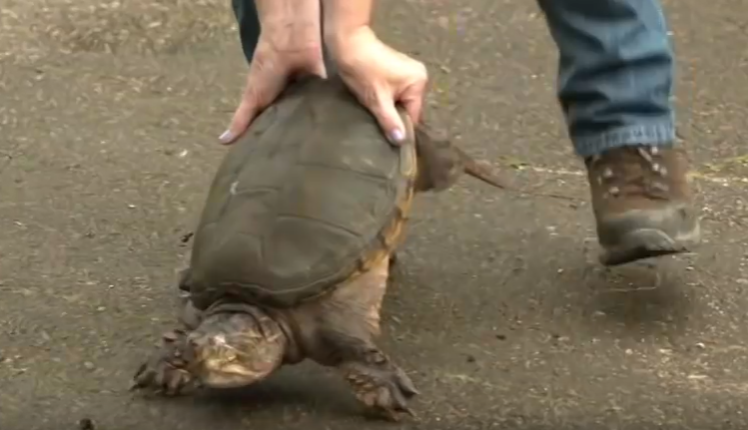Imagine you are holding a hamburger in your hands.
That is exactly the way you should hold a small turtle while helping it cross the road.
And at this time of year, more turtles are finding their ways onto roadways in search of mates and the perfect nesting site, so drivers should be on the lookout, said Kristyn Ferguson, program director with Nature Conservancy of Canada.
“They love the gravelly substrate, (but) they’re exposed to traffic,” she told BradfordToday, noting turtles like to dig their nests in soft gravel along the sides of roads.
“Keep your eyes on the road for the dome shell with the eyes poking out.”
In a community like Bradford West Gwillimbury, with turtle-crossing signs in areas such as along Canal Road in the Holland Marsh, turtles start to make their appearance in the springtime as the weather gets warmer, Ferguson said.
“It tends to be through the spring and fall months it’s at its peak,” she said. “The water’s cold and they’re coming out to warm up.”
Although summer has now arrived and temperatures are starting to spike, the creatures are still vulnerable now until about October, according to the conservancy.
Turtles may spend most of their lives in small areas, but they can sometimes wander as far as 10 kilometres — and even just a five per cent increase in annual mortality rates can put an entire population at risk, according to the conservancy.
Currently, all eight turtle species in Ontario are at risk.
“Turtles are not just adorable, they’re an important part of wetland ecosystems,” Ferguson said. “They help keep wetlands clean and healthy by eating dead plants, insects and animals, and play the role of the wetland janitor.”
There are a few things people can do to help a turtle if they see one moving slowly across a road.
For small turtles, such as Blanding’s turtles, the hamburger technique works well, Ferguson said, adding hold the turtle close to the road.
For snapping turtles, which “look like a dinosaur with a spiky tail,” she said a different method is better because they cannot put their heads in their shells so they may turn to snap at someone trying to help.
There are two sort-of handles at the back of their shells. Grasp those with both hands and lift the turtle’s backside in the air, and walk forward, wheelbarrowing it across the street, Ferguson said.
For any kind of turtle, she added, make sure to take them in the direction they were headed, otherwise they may just turn around and try to cross the road again.
“They are very determined where they were headed,” Ferguson said.
With turtles in Ontario at risk and vulnerable at this time of year, she said, “now it’s more important than ever to do everything we can to protect them.”
And helping a turtle cross the road “will make you feel like a superhero.”
How to help turtles cross a road:
- To help a turtle safely cross the road, first make sure the road is safe for you to pull over and help. Put your safety first.
- Move the turtle in the direction it was going, otherwise it will likely try to cross again.
- For turtles that hide their heads in their shells (like the Blanding’s turtle and the Midland painted turtle), simply pick the turtle up and carry it across the road. Carry it close to the ground — you don’t want to drop it.
- To move snapping turtles and avoid injury, lift using the “handles” on either side of their tails on the back of their shells and “wheelbarrow” them across the road on their front legs. If you have a car mat or a shovel, carefully slide the turtle onto this and drag it across.
- Back away, and let the turtle be. You don’t want to cause stress.
- Pushing or shoving turtles across roads with your feet or sticks isn't advisable. Their shells aren't as thick underneath, and rough pavement can do a lot of damage.
— Nature Conservancy of Canada
